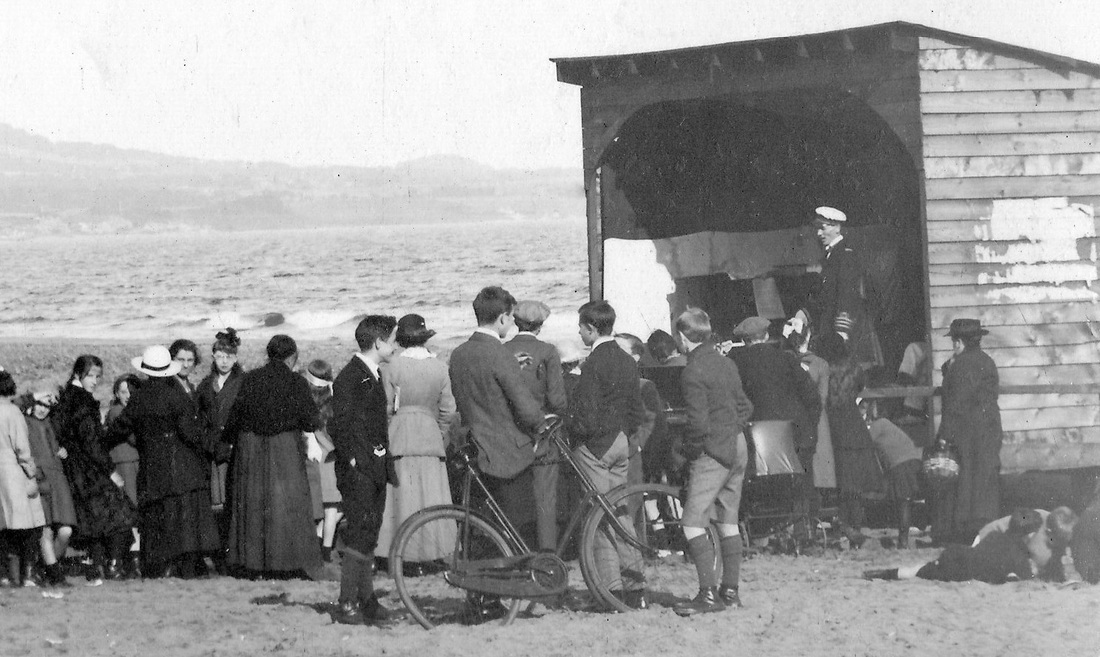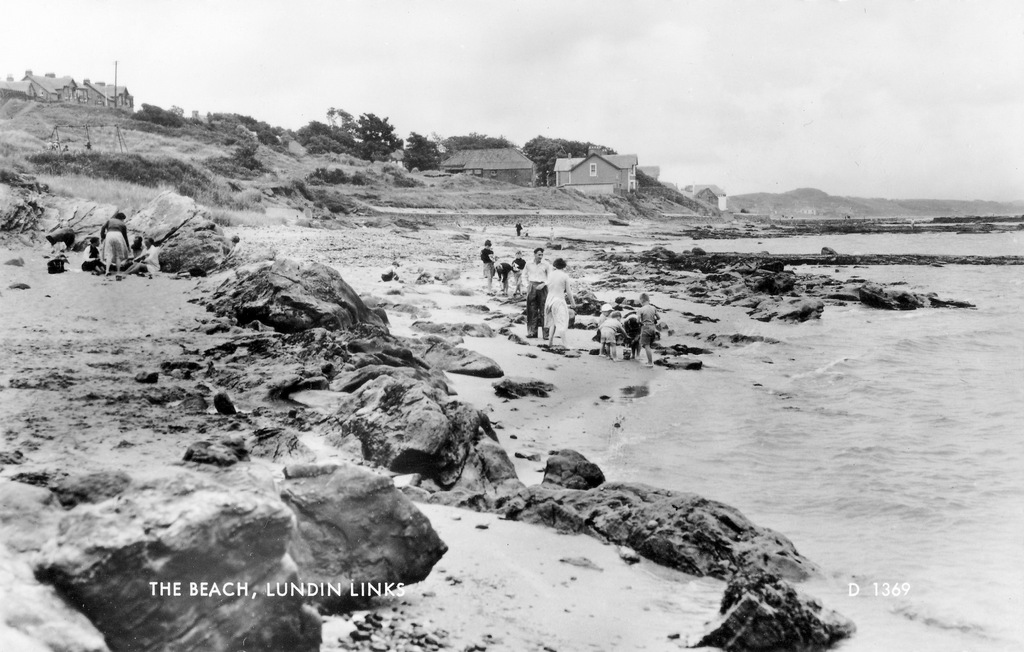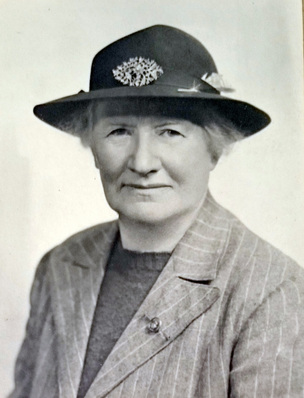For those of you less interested in making sense of little specks in the distance and more interested in the people in the foreground - some detail of them at the foot of the post!
|
This wonderful busy image of Leven Beach, with Lundin Links and Lower Largo in the distance, dates to the 1910s. While some form of entertainment sets up, and a crowd gathers, a photographer diverts the attention of some of the audience. The quality of the photograph means it's possible to make out individual buildings further round Largo Bay. The annotated cropped image below shows the detail. From left to right, I have picked out the houses along Leven Road, Lundin Links Station, Ravenswood and Elmwood boarding houses, the house on Golf Road belonging to clubmaker David Patrick, the boarding houses which became Peacehaven, the Lundin Golf Club House, the Victoria Hotel, the houses of Woodlands Road, the Crusoe Hotel and the far end of Lower Largo, namely The Temple.
For those of you less interested in making sense of little specks in the distance and more interested in the people in the foreground - some detail of them at the foot of the post!
0 Comments
This image dates from the early years of the twentieth century and looks down Crescent Road in Lundin Links from just opposite 'Bourtree Brae House' towards the junction with Links Road. The houses on the right side of the road were already 50 years old by the time this photograph was take, while those on the left in the distance would have been much newer. The house in the foreground to the right was designed by James Campbell Walker c1860 but by the time this image was captured it had been extended to the right and a porch added to the front entrance.
The bare trees, heavily clothed figure walking along the street and the suggestion of frost on the grass make this a wintry scene. The south side of Crescent Road is undeveloped beyond the building behind the curve of the street in the distance. That building is, one-time boarding house, 'Lindisfarne', at the crossroads with Links Road (see detail below). Is was later subdivided into two homes - the ground floor flat retaining the name 'Lindisfarne' while the upper flat became named 'Glenartney'. Before this house was built, golf was played on the site. The beach at Lundin Links is busy in this c1950 view. The number of people in the photograph and the variety in the scenery make it well worth zooming in on some of the detail. Firstly, below are two close-ups on the main groups of beach-goers. Toy boats and buckets and spades provide the entertainment for the children. Rocks provide some shelter for the adults. The swings up on Massney Braes are being well-used too. The first image below shows a joiner's workshop on the left behind the sea wall. This was originally the pan house for the salts works at Drummochy and was demolished in 1967. On the right is Drum Park.
At the foot of the post is some detail of the pier at Lower Largo, with quite a few people walking on it. In the distance are the houses of The Temple and a suggestion of steam rising from a passing train....or perhaps just a scratch on the photograph? The previous post contained excerpts from the notebooks of Leonora Rintoul, kept during the first half of the last century. Her lifelong friend and fellow ornithologist, Evelyn Baxter, kept similar notebooks over the same timeframe. Although the vast majority of the notes related to bird life and weather conditions, there were a few references to the locality (both ladies lived in Upper Largo). Here are a couple of examples... 26 Feb 1933 Very cold. A huge sea; at nearly high water it was dashing right up to the top of the Crusoe Hotel. It threw up logs of wood, sea-weed, etc into Lower Largo street. 21.7.1953 For the first time in ages a bird had pecked a hole in my milk bottle top. Miss Baxter outlived her friend, Miss Rintoul, by six years and must have felt the loss of such a kindred spirit deeply. The pair had revolutionised bird migration theory by relating it to weather conditions and had produced the classic book "The Birds of Scotland" together. After Miss Rintoul's death in May 1953, Miss Baxter wrote a letter in the August to a mutual friend where she stated "Miss Rintoul's death has made us all very sad. We shall miss her terribly in many ways". She goes on to explain that Miss Rintoul's home, Balsusney, had been let and that "I have been so busy helping to clean it up in addition to other things that I've had little time for birding".  However, Evelyn did return to birding in time. In 1955, Miss Baxter received an honorary degree from the University of Glasgow (see image). In 1957 she attended the 'coming of age' dinner of the Scottish Ornithologists' Club (SOC), which had originated in 1936. There she was presented with a clock to mark the occasion (see image at foot of post) by Sir Arthur Duncan (chairman of the Nature Conservancy Council). Duncan was the first chair of the SOC and Misses Baxter and Rintoul were the first (joint) presidents. Evelyn Baxter passed away on 1 October 1959 but both she and Miss Rintoul are still spoken of fondly at the SOC Headquarters. With thanks to the Scottish Ornithologists' Club for both the information and images. The journals of Evelyn Baxter and Leonora Rintoul are held at the Scottish Ornithologists' Headquarters in East Lothian, as they primarily contain copious notes on the bird life of both Fife and other areas visited by the two Upper Largo-based ornithologists. However, within these notebooks are also a few snippets of general comment on local life around Largo. Below are some examples from the journals of Rintoul (pictured). She named her home in Upper Largo 'Balsusney' after her grandfather's (John Jeffrey's) home in Kirkcaldy, Balsusney House, where she spent much time as a child. "16 Sept, 1933 Balsusney
Saw a Humming Bird Hawk Moth in the garden here, it was dipping into the flowers of the phloxes." On 7th April 1934, Rintoul writes of the Balcormo point to point race... "P to P Races morning sunny and promised well but snow began about 12:30 and got worse and worse till the Point Races had to be abandoned." 30th May 1938 There are very few Hirondinae about, we saw two pairs of House-Martins trying to nest on Dr Eggeling's house and one picking up rind for its rest in Lundin Links." During the Second World War, it became hard to observe wildlife due to a ban on carrying binoculars, as reflected in the following entries... 26.9.40 The War has made observation very difficult as we can't carry glasses. 6 Jan 1941 Terribly cold, 26° of frost at Coates House. The bath in my dressing room at Balsusney has ice floes in it. The rocks on the shore are covered in ice and there are floes along the shore like the pictures of the Arctic regions. We can't see very well without our glasses. 5 Oct 1941 I have been dreadfully bad about notes, but it is really impossible to make observations when one can't carry glasses. 7 Feb 1943 Have been very remiss about notes but it is difficult to bird without glasses. 2nd Dec 1944 A wet morning and lovely afternoon went to Lundin LInks shore. The ban is off and we may now carry glasses again, so can bird properly once more. Here are some post-war entries... 14.3.47 Lovely day. Fearful drifts. Went out to see drifts, Kirkton Den full, 8ft drift at top of Station Brae. No trains round the coast and no buses. 15 May 1950 Watched a school of about 1000 Pilot Whales in Largo Bay. They swam to and fro and splashed and puffed. It was most exciting to watch them. 18.9.51 A hedgehog on the doorstep! in the evening 19.9.51 Some of the Grove rooks roosted in the rookery with much talk this evening. It is the first time any have roosted since 10th Sept. On the buddleia at the Grove drawing-room window, we saw three Peacock butterflies and a small Tortoiseshell and two or three Red Admirals. 'The Grove' was the name of the neighbouring house to 'Balsusney' - that of friend, and fellow ornithologist, Evelyn Baxter. Some excepts from her notebooks in the next post. With thanks to the Scottish Ornithologists' Club for both the information and image. Although linen manufacturer John Jeffery was associated with Kirkcaldy for much of his life, owning Balsusney House next to the town's railway station (now the site of the Kirkcaldy Museum and Art Gallery shown below), he also rented Largo House for many years. In fact both John and his wife Margaret died at Largo House - in 1886 and 1879 respectively. Mr and Mrs Jeffrey's granddaughter was Leonora Jeffrey Rintoul, editor of the 'Largo Village Book' published in 1932. John Jeffrey is mentioned twice in the book.... "All spinning and weaving has ceased for many years now (1932), but in 1872, when my grandfather, John Jeffery, came as tenant to Largo House, there were still a good many hand-looms both in Upper Largo and in Lundin Links, though these did not go on long after that." ....and in a later section... "The linen industry in Largo steadily decayed from the time of the introduction of power looms in Kirkcaldy and Dunfermiline, until by the end of the nineteenth century there were no hand looms left. In 1872 there were still a good many hand-loom weavers, especially in Lundin Mill and Lower Largo, and my mother has often told me of old men who used to come to the station and say to my grandfather, "won't you give me a wab Mr Jeffrey, " and I'm glad to think that as long as they lived he did give them webs enough to keep them employed." John Jeffrey was born in Biggar in 1818 to Robert Jeffrey and Margaret Jack. John and his brothers went into the family business as linen manufacturers which extended ultimately to multiple countries. As a young man, he came to Kirkcaldy to establish a Fife base for the linen firm of John Jeffrey & Sons, Glasgow. In the 1851 census he could be found lodging at a property on Nicol Street, Kirkcaldy and was recorded as "manufacturer employing 1100 hands (linen) in Ireland, Forfar, Fife....". Later that year he married Margaret McGlashan in the town. On 7 September 1854, the Fife Herald noted that Jeffrey had "concluded a bargain on Friday with the Edinburgh, Perth and Dundee Railway Company, for the sum of £3000, for Balsusney House and grounds." A painting of the long-demolished Balsusney House can be seen here... http://www.bbc.co.uk/arts/yourpaintings/paintings/balsusney-house-125008 Based at Balsusney for many years, John oversaw the building of Balsusney Works, which was a major power loom factory in the district. It would continue to flourish many decades after John Jeffrey's death. When John Jeffrey passed away, the Fife Free Press of 28 August 1886, announced that...
"We deeply regret to record today the demise of our valued and highly-esteemed townsman, Mr John Jeffrey, of Balsusney and Largo House. The event, not entirely unlooked for since the beginning of the week, occurred on Thursday afternoon at Largo, after a protracted illness.... Mr Jeffery was a gentleman of a naturally studious mind, and of fine literary tastes. He was a great reader, who derived much real pleasure and profit from books, from which, combined with his travelling experiences in many lands, he possessed an almost unlimited fund of knowledge" The article spoke also of his role in establishing Kirkcaldy Musical Society and his special interest in plants and trees. He worked alongside Mr Charles Howie, late secretary of the Largo Field Naturalists' Society on the 1879 book "The Trees and Shrubs of Fife and Kinross". Jeffery was also a Justice of the Peace for the county of Fifeshire. Suffering the loss of his wife and his son in the late years of his life, John Jeffery was survived by his two daughters, Helen and Margaret. In 1972 Largo Pottery was established in Lower Largo. The shop was at 68 Main Street (now part of Largo Baptist Church and once home to the Post Office). Owner Anne Lightwood sold handmade pottery made in a nearby workshop. A few years later, the workshop moved into refurbished cottages known as 'Doctor's Vennel' on the other side of the street. These new facilities allowed output to increase and the reach of the business to extend more widely. Visitors could watch the pottery-making process from preparation of the clay, to throwing, turning, glazing and firing. The photograph below shows Anne Lightwood at work in 1980 and is taken from the book "Sea Toun of Largo" by Ivy Jardine (1982). Mrs Lightwood was brought up in Edinburgh and attended the city's College of Art. Working as an art teacher, she came to Largo with her family in 1967, where she eventually moved full-time into pottery production. The village and its surroundings supplied Anne with much inspiration. In 1982 she was quoted in the East Fife Mail (13 January) as saying "I get ideas for works from walking along the beach and sometimes people suggest things to me. I'm sure I get more inspiration here than I would if I was living in a town". Vases, jugs, bowls, cups and planters were among the objects produced and these items were later joined in the shop by candles, baskets, cards and other crafts. However, by 1982 the shop had to close, after experiencing a couple of quiet seasons, although pottery production continued in order to supply other outlets.  In the summer of 1984 a fire tragically destroyed the pottery workshop. The East Fife Mail of 4 July described how fire broke out around 7pm and although brought under control by 9pm, it had gutted the building and destroyed most of the stock. Many fellow potters from around Fife offered Mrs Lightwood the use of their workshops and help with materials and equipment. Anne Lightwood moved to St Andrews and set up a pottery there. A new house was eventually built on the site of the old 'Doctor's Vennel'. Largo pottery can still be found in many homes around the world. The previous post covered Braehead and Cardy House, and this view is taken from just a little further west on Lower Largo's Main Street. The gate of Cardy House is visible but the Braehead Cottages (also known as East End Cottages) are obscured by the main buildings featured. The low, white building on the left was the Loomshop Studio. This was originally at No. 119 Main Street, as pictured, but later migrated across the street to No, 122 as the Loomshop Gallery (the vacated building becoming the Gillies Studio). The building shown at No. 119 was originally a row of weavers' cottages. These were converted into a workshop during the 19th century and which was used by the Gillies brothers.
The building was restored and converted in 1964 for artists to show their work and was named the Loomshop Studio. The venture was managed and promoted for 32 years by Jimmy Mowat. Over the years many artists throughout Scotland exhibited in the gallery. In 1984, the East Fife Mail reported (on 28 November) on the Loomshop Gallery's 20th Christmas Exhibition. There was a special collection of art works from a range of artists who had been associated with the gallery over the years. This included Elizabeth Blackadder, Sir Robin Philipson and Alberto Morrocco. The Loomshop Gallery closed in 1996. If you have recollections of it, please comment. I love this postcard image of 'Braehead' looking towards Cardy House. This is now the east end of Main Street, Lower Largo just before the road turns sharply down towards the shore. Picking out some of the detail, the water tap between the two sets of gates to Cardy House is visible. There appears to be a sleeping dog outside the cottage on the left. In addition to the woman and child who look like they are about to enter another of the cottages, there are two slightly ghostly men walking along the road about to turn the corner on the right.
When standing in the ruins of the houses which once stood at Viewforth, east of Lower Largo, I cannot help but imagine what it might have been like to live there. I think the answer depends upon when you lived there, who you were and what you did for a living. The idea of being someone like the artist Hugh Cameron, who often spend summers there, sitting in a studio painting scenes inspired by the above view is very appealing. However, the thought of being one of the handloom weavers or fishermen that were recorded there in the 1841 census is less so. Working there during a cold, dark winter would be entirely different from being a summer visitor taking the sea air and going bathing.
Going further back, imagine the arduous work of the salters of the 18th century. Standing over hot pans of sea water and shovelling coal and salt must have been exhausting. This National Library of Scotland footage from 200 years later at another salt works gives an impression of the type of labour involved... https://www.youtube.com/watch?v=RZZu23SaF04 |
AboutThis blog is about the history of the villages of Lundin Links, Lower Largo and Upper Largo in Fife, Scotland. Comments and contributions from readers are very welcome!
SearchThere is no in-built search facility on this site. To search for content, go to Google and type your search words followed by "lundin weebly". Categories
All
Archives
July 2024
|




















 RSS Feed
RSS Feed
